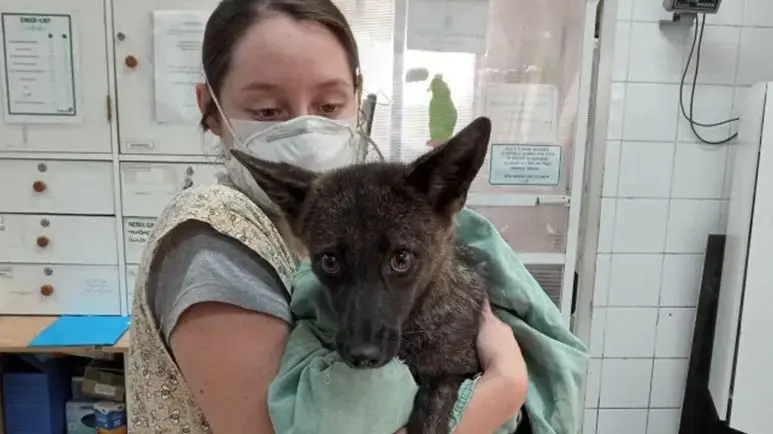When Nature Defies Boundaries: The Dogxim Case
In an extraordinary testament to nature's unpredictability, scientists confirm the existence of a hybrid animal that blurs the lines between domestic and wild.

STORY AT-A-GLANCE
- Researchers in Brazil used genetic testing to confirm the existence of the first verified dog-fox hybrid, dubbed a “dogxim”
- The female dog-like creature was hit by a car and taken to a wildlife rehabilitation center, where staff took notice of her fox-like ears, appetite for rodents, and her dog like bark
- Genetic testing revealed the dogxim was the offspring of a female Pampas fox and a male domestic dog
- Experts believe the dogxim’s existence is concerning as it relates to the impact pet dogs might have on animal populations and their survival
Dogs and foxes are both members of the canine species but are distinctly different. Until recently, scientists assumed it was impossible for them to breed — until the discovery in 2021 of a dog-fox hybrid in Brazil.1 Throughout history there have been unconfirmed reports of fox-dog hybrids,2 but none have been validated using genetic testing.
The animal in Brazil, known as a “dogxim” (a cross between a dog and a Pampas fox), is the subject of a study published in 2023 in the journal Animals.3 According to The Conversation, the dogxim’s existence “raises concerns about the impact that our pet dogs might have on wild animal populations and their survival.”4
The little dog-like creature, a female, was hit by a car and taken to a wildlife rehabilitation facility, where she quickly raised eyebrows among the staff, who noticed she exhibited an unusual mix of physical and behavioral characteristics. For example, her erect ears and taste for small mammals seemed fox-like, but her barking was similar to a dog’s. She appeared to be medium sized as dogs go, with large, pointy ears, a long snout, a jet-black nose, and brown eyes. Her coat was black brown with specks of white and grey.
Genetic testing showed that she was indeed the first documented case of a dog-fox hybrid — mom was a Pampas fox and dad was a domestic dog. She had a total of 76 chromosomes — the domestic dog has 78 and the pampas fox has 74.
Most Known Hybrids Are the Result of Human Meddling
Normally, animals only mate with others of their species. When two different species mate and produce offspring with mixed genetic ancestry, it’s called hybridization. Differences in the number of chromosomes typically render distinct species genetically incompatible. In addition, courtship and mating behaviors tend to be species-specific.
Most known hybrids, e.g., mules (horse and donkey), ligers (male lion and female tiger), and tigons (male tiger and female lion), are products of human intervention. The more closely related and therefore genetically alike two species are, the better the chance of successful hybridization.
Domestic dogs and grey wolves, for example, only relatively recently diverged, so wolfdog hybrids are somewhat common because their genetics, reproductive anatomy, and behavior remain similar. (Read here for more information on the fate of wolfdogs and why the for-profit practice of mating wolves and dogs has produced generations of animals who more often than not, meet with a tragic end.)
Most hybrid animals are sterile, so on the rare occasion two species produce young, nature creates a “biological dead-end” in the offspring. However, this isn’t the case with every hybrid. Per The Conversation:
“Hybrid offspring are not always infertile, and some people are concerned about how this affects the long-term survival and purity of individual species. Hybrids can outcompete and eventually even replace their parent species. For endangered species with small, fragile populations, this is a serious threat.”5
Whether or not the dogxim was fertile remains a mystery, as it was not verified during her time at the wildlife rehab center, and according to various reports, including one from the U.K.’s Metro, she has died.6 She was apparently moved to a conservation center in south Brazil in late 2021 after receiving veterinary care and genetic testing at the rehab center. According to a conservationist who had helped care for the dogxim, she was healthy, with no indication of health problems, when she left the wildlife rehab center headed for south Brazil.7
When scientists who had studied her asked for photos the following August, they were told she had died six months earlier, and no autopsy was conducted. An investigation into the animal’s death is underway in the Brazilian state of Rio Grande do Sul.
How Many Other Hybrids Are Living in the Wild?
According to researchers, the dogxim hybrid strongly suggests that contact between wild and domestic species is increasing, likely as a result of human settlements encroaching on wild habitats. As explained in The Conversation:
“The dogxim might well be a warning of the destructive impact humans and domesticated animals are having on biodiversity. We don’t know how many other hybrids may be living in the wild. Although the Pampas fox is not considered endangered, this example of hybridization between a domestic and wild species signals the importance of monitoring interactions between different species, to protect vulnerable or numerically low populations.”8











